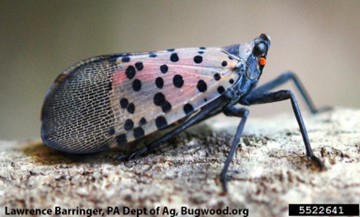First detection of spotted lanternfly in Michigan
A new insect brings new problems.

Spotted lanternfly (Lycorma delicatula) has been hitchhiking across much of the northeastern United States since its discovery in southeastern Pennsylvania in 2014. The pest can now be found in at least 13 states, including a small, localized population in Oakland County, the first known occurrence of live spotted lanternflies in Michigan. This infestation appears to have been caused by spotted lanternflies hitchhiking into Michigan on live plants/trees imported from one or more nurseries in infested states.
Native to China, spotted lanternfly is in the family Fulgoridae which includes at least 125 genera of insects, most of whom are found in tropical areas feeding on trees. Many planthoppers are small, and brown or green in color so they blend in with the plants they use as hosts. Lanternflies, however, are often amazing, with bright colors and a crazy long snout that arises from their head. Apparently old folk tales talk about how the long snouts glow in the dark – hence the “lantern” in the name lanternfly. In reality, the snouts don’t actually glow but species with names like “peanut bug,” “angry bride,” and “unicorns of the insect world” are worth checking out online!

Like all planthoppers, spotted lanternflies are sap feeders. Immature stages, called nymphs, and spotted lanternfly adults pierce trunks or branches of trees or the woody portions of vines to suck sap. Tree of heaven (Ailanthus altissima) is by far the favorite host of spotted lanternflies. This tree, another native of China, was imported into Pennsylvania in the late 1700s and can now be found across much of the U.S. It grows well on disturbed sites and poor soils and can often be found along highways and railroad tracks.
In addition to tree of heaven, spotted lanternflies can feed on grapevines, hops and fruit trees, and insecticides may be needed in areas where spotted lanternfly density is high. Many hardwood trees can also be fed upon by spotted lanternfly including black walnut, maples, willow and poplars.
Fortunately, this is NOT a pest that is likely to kill its hosts. Flagging, i.e., few dead shoots, has been observed on walnut or soft maples in Pennsylvania where high densities of spotted lanternfly were feeding. But overall, the impact of spotted lanternflies on trees is mainly caused by the prodigious amount of honeydew the insects excrete as they feed.
Plant sap is mostly water and sugars (carbohydrates), which means that sap feeding insects must consume and process lots of sap to get the nutrients they need to grow, develop, and reproduce. They need to do something with all that extra sugar-water – called honeydew. In the case of spotted lanternflies, the insects excrete it – and they excrete a lot of it! Honeydew will literally rain down from heavily infested trees, coating plants, driveways, and outdoor items beneath the trees. Black sooty mold then grows on the honeydew, which can reduce growth and vigor or shrubs or herbaceous plants. Wasps and ants will often be attracted to the honeydew. It is not pleasant to reside in an area where spotted lanternfly densities are high, especially if thousands of spotted lanternfly adults are feeding, squirting out honeydew (check out the online videos!) and generally making a mess. Fortunately, this doesn’t last for more than a few weeks. Insecticides can be used to protect trees and vines. Although spotted lanternflies are really good at jumping (hence the “hopper” in the name planthopper), swatting the insects with a flip-flop might relieve some stress!
What does the spotted lanternfly detection mean for Michigan?
At this point, the spotted lanternfly infestation in Oakland County appears to be small and localized. Surveys to determine the extent of this infestation are underway and efforts to use insecticides to contain the population have been launched. Based on experience from other states, however, it seems very likely that spotted lanternflies will continue to spread in Michigan. Adult spotted lanternfly are not great fliers, but they can disperse short distances into new areas. Artificial dispersal by people accidentally moving egg masses or other life stages is more problematic. Several infestations in other states have resulted from spotted lanternflies hitchhiking on vehicles, including cars, semi-trucks, and trains. Once established, spotted lanternfly population densities will increase over time, eventually reaching the outbreak levels that people are seeing in eastern states this summer.
If you think you have found spotted lanternfly, note your location – either an address or GPS coordinates of the location. Try to capture an insect or two and put it into a Ziplock bag or small jar. At the very least, take a picture while noting your exact location. Suspect spotted lanternfly should be reported to Eyes in the Field, the website regulatory officials will monitor.
If you know of tree of heaven growing near you, Michigan State University Extension strongly suggests reporting its location into the Midwest Invasive Species Information Network, or MISIN. These locations may be extremely valuable in the future if statewide eradication measures become necessary.
To learn more about spotted lanternfly, check out this Michigan State University Extension article, “Spotted lanternfly, a colorful cause for concern.”



 Print
Print Email
Email


